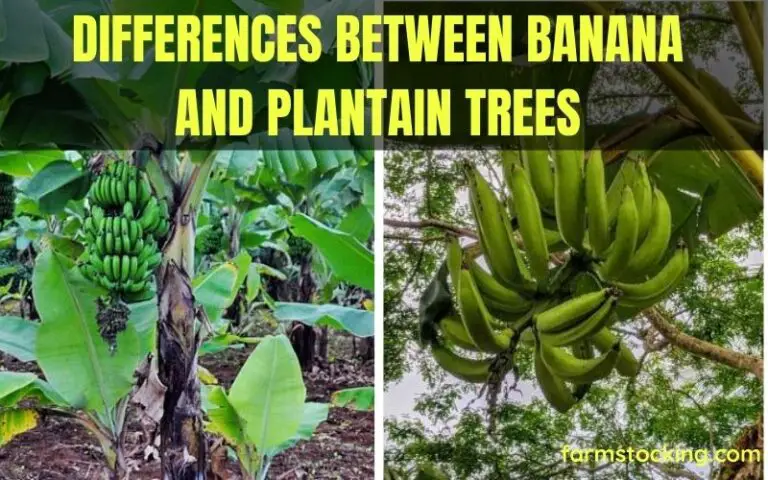Banana vs Plantain Trees: Understanding the Difference Between These Popular Fruits
Bananas and plantains are two of the most widely consumed fruits in the world; but do you know the difference between them? These two relatives may look similar, but they have distinct characteristics that set them apart. Whether you`re a fruit enthusiast or a curious foodie, understanding the differences between bananas and plantains can help you make informed culinary choices.

In this article, we`ll cover everything you need to know about these two fruits. From their history and cultural significance, to their physical and taste differences, to their health benefits and uses, we have you covered. And if you`re looking to explore new recipes and dishes using bananas and plantains, stay tuned – we have some tasty ideas for you. So, let`s dive in and learn more about the difference between banana and plantain trees.
What are bananas and plantains?
Bananas and plantains are two closely related fruits that belong to the same genus, Musa. While they may look similar on the outside, there are some key differences between the two.

Bananas are typically eaten raw and have a sweet taste when ripe. They are usually smaller than plantains and have thinner skins, making them easier to peel. Bananas also tend to have a softer texture compared to plantains.
Plantains, on the other hand, are often cooked before being eaten. They have a starchy texture and a less sweet taste compared to bananas. Plantains also have thicker skins that can be difficult to peel.
Both bananas and plantains are rich in potassium, fiber, vitamin C, and vitamin B6. These nutrients make them an excellent addition to any diet.
Interestingly enough, bananas and plantains also play an important role in many cultures around the world. In some countries, they are used as a staple food source while in others they hold significant cultural or religious importance.
Overall, whether you prefer your fruit raw or cooked – there is no denying that both bananas and plantains offer numerous health benefits along with their unique flavors!
The history and cultural significance of bananas and plantains
Bananas and plantains have a rich history and cultural significance that spans centuries. These fruits have been cultivated for both their nutritional value and their versatility in cooking, making them a staple in many cultures around the world.
Bananas were first domesticated in Southeast Asia around 7,000 years ago. They quickly spread throughout the region and eventually made their way to Africa, where they became an important crop for many communities. Plantains, which are similar to bananas but larger and less sweet, originated in West Africa and were also widely cultivated throughout the continent.
As Europeans began exploring new lands, they brought bananas with them on their voyages. The fruit became popular in the Caribbean and Latin America, where it was used as a cheap source of nutrition for enslaved people working on plantations.
Today, bananas are one of the most widely consumed fruits in the world. They are valued not only for their taste but also for their high nutritional content; they are rich in potassium, fiber, vitamin C, and other essential nutrients.
In many cultures around the world, bananas hold special cultural significance. In India, for example, bananas are associated with Lord Vishnu and are often offered as a religious offering. In some African countries like Cameroon or Nigeria , plantains feature prominently in traditional dishes like fufu or matoke.

Overall,between its rich history spanning centuries across continents to its significant role as an important food crop worldwide today , it is clear that bananas (and plantains) hold deep cultural significance beyond being just another fruit on our plate .
What are the physical and taste differences between bananas and plantains?
Bananas and plantains are both members of the Musaceae family, but they have distinct physical and taste differences. Bananas are typically smaller in size and have a sweeter flavor compared to plantains. Plantains, on the other hand, are larger and have a starchy texture with a less sweet taste.
One major difference between bananas and plantains is their ripening process. Bananas can be eaten when they are still green or yellow, while plantains need to be cooked before consumption. This is because unripe plantains contain high levels of starch which can be difficult for the body to digest.
In terms of nutritional value, bananas and plantains both offer important vitamins and minerals such as potassium, vitamin C, B6, fiber, magnesium among others. However due to their differences in starch levels one fruit may suit one’s dietary needs better than the other.
Whether you prefer your fruit sweet or starchy depends on your personal taste preferences. Nevertheless it’s important to know how each fruit differs so that you can make informed decisions about what you eat!
The health benefits and uses of bananas and plantains.
Bananas and plantains are two of the most versatile and nutritious fruits available. Not only do they taste great, but they also offer a wide range of health benefits that can improve your overall well-being.

« how much is a strawberry banana smoothie
when bananas go bad »
One of the most notable benefits of bananas and plantains is their high potassium content. Potassium is essential for maintaining healthy blood pressure levels, as well as proper nerve and muscle function. Additionally, bananas and plantains are a good source of vitamin C, which can help boost your immune system and reduce inflammation in the body.
But that’s not all – both fruits also contain fiber, which can aid in digestion and promote feelings of fullness. This makes them an excellent choice for anyone looking to maintain a healthy weight or improve their gut health.
Furthermore, bananas have been shown to have mood-boosting properties due to their high levels of tryptophan – an amino acid that helps regulate serotonin levels in the brain. This may explain why eating a banana can often make you feel happier!
Plantains also offer unique benefits due to their higher starch content compared to bananas. This makes them a great source of sustained energy for athletes or anyone looking for longer-lasting fuel throughout the day.
In addition to being delicious on their own, bananas and plantains can be used in a variety of recipes – from sweet desserts like banana bread to savory dishes like fried plantain chips. So next time you’re looking for a healthy snack or ingredient for your meals, consider reaching for this versatile duo!
Recipes and dishes using bananas and plantains.
Bananas and plantains are versatile ingredients that can be used in a variety of dishes, from sweet to savory. These fruit cousins offer unique flavor profiles and nutritional benefits that make them a must-have in any kitchen.
One delicious recipe using bananas is banana bread. This classic treat can be made with ripe or overripe bananas, which gives it a natural sweetness without the need for excessive sugar. Adding nuts or chocolate chips to the batter elevates this already delicious bread to new heights.
For those looking for a more savory option, try making plantain chips. Thinly sliced plantains are fried until golden brown and crispy, then seasoned with salt or other spices. These chips make for an excellent snack on their own or served alongside guacamole or salsa.
Another creative way to use bananas is by incorporating them into smoothies. Blend together frozen bananas with almond milk and your favorite fruits for a refreshing beverage packed with vitamins and minerals.

Finally, don’t forget about using plantains in main dishes such as mofongo, which is mashed plantains mixed with garlic and pork cracklings. This traditional Puerto Rican dish is both hearty and flavorful.
Incorporating bananas and plantains into your cooking repertoire not only adds variety but also provides numerous health benefits such as high fiber content, potassium, vitamins C & B6 while also adding natural sweetness without excessive calories!
Check out our other articles to find out even more about banana.
Bananas and plantains are fruits with remarkably different histories and uses, making them a fascinating subject to explore. From cultural significance to health benefits and recipes – there’s something for everyone when it comes to these remarkable fruits! We hope you’ve enjoyed learning more about bananas and plantains today, so be sure to check out our other articles if you’d like to find out even more about banana.













